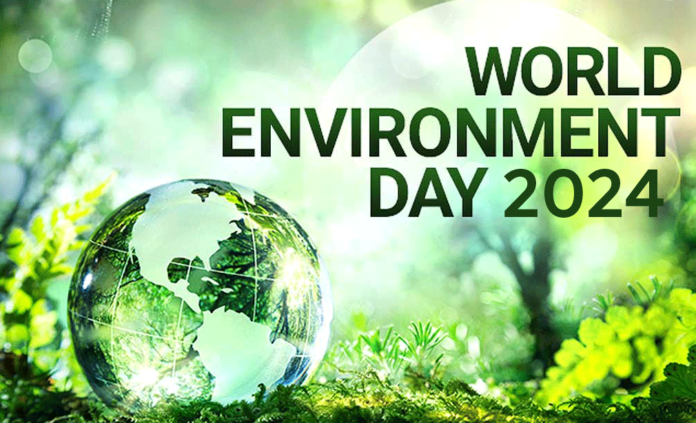World Environment Day holds significant global importance as it raises awareness, promotes advocacy, catalyzes policy impact, fosters education and engagement, inspires innovation, and empowers communities. By encouraging individuals and organizations to take proactive measures, WED contributes to a sustainable and resilient future for all.
Theme for 2024:
In 2024, the world unites under the theme of “Land Restoration, Desertification, and Drought Resilience,” emphasizing the urgent need for environmental stewardship. This article delves into the history, significance, and activities surrounding World Environment Day 2024.
Key facets of this theme include:
- Land Restoration: Rehabilitating degraded lands to improve soil health, water retention, and vegetation cover.
- Desertification Prevention: Implementing measures to prevent the spread of deserts, which can result from unsustainable land management and climate change.
- Drought Resilience: Developing strategies to cope with water scarcity, ensuring communities can withstand and recover from droughts.
Adopting the Theme of World Environment Day 2024: Opportunities for the Indian Construction Industry
The theme of World Environment Day 2024, “Land Restoration, Desertification, and Drought Resilience,” underscores the urgent need for environmental conservation and resilience. For the Indian construction industry, aligning with this theme presents a crucial opportunity to integrate sustainable practices into its operations. This article explores how the sector can adopt and implement the World Environment Day 2024 theme to foster environmental sustainability and resilience.
1. Embracing Sustainable Land Use Practices:
The construction industry can prioritize land restoration efforts by adopting sustainable land use practices. This involves promoting the reuse of brownfield sites and encouraging the development of green infrastructure to minimize land degradation.
2. Implementing Desertification Mitigation Strategies:
Integrating desertification mitigation measures into construction projects can contribute to environmental resilience. Utilizing indigenous vegetation, implementing soil conservation techniques, and adopting water-efficient landscaping practices are effective strategies to mitigate desertification risks.
3. Promoting Water Conservation and Drought Resilience:
Implementing water-efficient building designs and construction techniques can significantly reduce water consumption in the construction process. Utilizing rainwater harvesting systems, greywater recycling, and drip irrigation in landscaping can enhance drought resilience and promote sustainable water management practices.
4. Integrating Sustainable Materials and Technologies:
Embracing eco-friendly construction materials such as recycled aggregates, bamboo, and sustainable wood can reduce the environmental footprint of construction projects. Additionally, leveraging innovative technologies like green building materials, energy-efficient HVAC systems, and solar panels can enhance sustainability and reduce resource consumption.
5. Fostering Green Building Certification:
Encouraging the adoption of green building certification standards such as LEED or GRIHA can promote sustainable construction practices. Offering incentives or tax benefits for green building projects can incentivize industry-wide adoption and contribute to environmental conservation efforts.
6. Enhancing Stakeholder Collaboration and Awareness:
Collaborating with government agencies, environmental organizations, and local communities is essential for promoting sustainable construction practices. Conducting awareness campaigns and training programs on sustainable construction techniques can raise industry-wide awareness and foster a culture of environmental stewardship.
Industry leaders take on Sustainability Abiding with the Theme of World Environment Day
Mr. Sridhar Samudrala, Founder, Hecta

“Sustainability is not just a trend in real estate investment; it’s a fundamental shift reshaping our approach to the market. Investors are increasingly recognizing that sustainable practices lead to long-term value and resilience, which are essential in today’s economic landscape. Properties that prioritize energy efficiency, resource management, and environmental impact are not only more attractive to tenants but also tend to deliver better returns and lower risks. This approach is redefining our industry, pushing us toward a future where sustainability, profitability, and social responsibility go hand in hand, ensuring a positive impact on communities and the planet.”
Mr. Mrinaal Mittal, Director, Unity Group

“Sustainability is a fundamental shift redefining real estate on World Environment Day. Developers and investors increasingly prioritize green building practices, energy efficiency, and sustainable materials. This transformation reduces environmental impact and enhances property values and occupant well-being. As climate change challenges intensify, the real estate industry must innovate to meet demand for eco-friendly spaces. Technologies like smart home systems, renewable energy sources, and water conservation measures are becoming standard. Sustainable real estate is proving that environmental responsibility and economic growth are not mutually exclusive but rather complementary paths to a resilient future.”
Mr. Lalit Aggarwal, Co-Founder & Vice Chairman of Signature Global (India) Ltd.

“As urbanization accelerates and water resources become increasingly strained, it is critical for industries such as real estate to take proactive measures to address the impending water crisis. As a responsible corporate, Signature Global has always adopted a proactive approach for ESG. The majority of our projects are either EDGE certified or IGBC gold-rated, demonstrating our commitment towards the environment. Through our various optimum water use practices, we save around 52% of water usage.
“These amenities include low-flow water faucets and toilets, rainwater collecting systems, and wastewater treatment and reuse facilities. By incorporating these techniques into the design and construction of our developments, we not only reduce our effect on local water resources but also improve the overall resilience of urban water systems. At Signature Global, we recognize the value of sustainable practices in ensuring the long-term survival of our cities and are committed to continuing our efforts to conserve natural resources like water, which is the elixir of life.”
Mr. Ashish Sharma, AVP Operations, Brahma Group

“The increasing focus on green buildings by developers highlights a significant shift towards sustainable construction practices. Moreover, driven by both regulatory incentives and market demands, developers are integrating energy-efficient designs, renewable energy sources, and sustainable materials into new and existing buildings. Furthermore, GRIHA is one such important certification that has encouraged real estate developers to design buildings focused on their resource consumption, waste generation, and overall environmental impact. The embrace of green building practices not only contributes to a clean environment but also enhances the quality of life for occupants through improved air quality and reduced utility costs. Furthermore, as green building practices continue to evolve, we can anticipate widespread adoption of net-zero energy buildings and smart technologies, leading to even greater efficiency and sustainability in the foreseeable future.”
Mr. Mahesh Anand, President, Nippon Paint India (Decorative Division)

“As a leader in the Green Movement, Nippon Paint is dedicated to building a more sustainable future and continuously striving for greater impact. Our commitment to sustainability has earned our factory the prestigious “GreenCo Gold” certification, acknowledging significant reductions in waste, water, and energy consumption. We proudly offer nearly 70 “GreenPro” paints, formulated to be environmentally friendly.
We are not just painting a green picture; we are actively creating a greener reality. Our sustainable production efforts have led to a 30% decrease in factory waste and a 45% drop in CO2 emissions, resulting in a reduction of carbon footprint and an increase in resource availability for land restoration. Furthermore, by reducing water usage by 60%, we conserve a vital resource for the future. Our tree plantation and rainwater harvesting initiatives directly support our local ecosystems and reduce our reliance on freshwater sources—a crucial step in combating climate change, a major driver of desertification and drought.
The future of a sustainable environment in the industry includes integrating circular economy principles, advancing green technology innovations, and fostering collaborative efforts across sectors. At Nippon Paint, environmental protection is a continuous commitment. While proud of our progress, we recognize there’s always more to be done. We invite our industry partners and customers to join us on this journey towards a healthier planet. Together, we can make a significant difference.”
Amit Porwal, Director at Aranyakaa Farms
“At Aranyakaa Farms, we’re dedicated to environmental change. This World Environment Day, we’re proud to share: converting wasteland into gardens with 20,000+ trees and vigorously advocating for plantation agroforestry, developing artificial lakes like our Vrindavan Project alone holds 45 lakh liter capacity lakes, and plans for 20-25 lakes to address water scarcity. We’re improving soil and crop yields through precision farming and rainwater harvesting. Our Land, Our Future, and Aranyakaa embody the essence of #Generation Restoration. Be a part with us in our commitment to sustainable environmental management.”
Conclusion:
As we commemorate World Environment Day 2024, let us heed the call to action for land restoration and sustainability. Through the adoption of sustainable land use practices, desertification mitigation strategies, water conservation measures, sustainable materials, green building certification, and stakeholder collaboration, the industry can contribute to a greener and more sustainable future.


